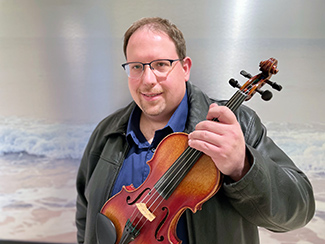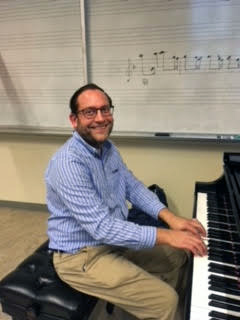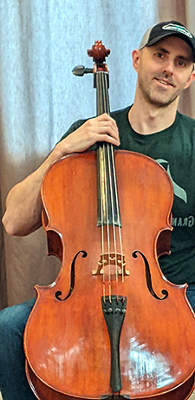Rhythm and Proofs: Finding Music in the Math
May 19, 2023 | By Michelle Franklin
Greek philosopher and mathematician Pythagoras noted, "There is geometry in the humming of the strings, there is music in the spacing of the spheres." Since then, everyone from the American Mathematical Society to the U.S. Department of Education to TedxTalks has explored not only the mathematics behind music, but also the musicality of mathematics. Three professors in UC San Diego’s Department of Mathematics share their own connections.
Todd Kemp, Professor of Mathematics
 Describe your research in one sentence: I use various mathematical tools to study random processes that occur in high dimensions and geometric contexts, with connections to theoretical physics, electrical engineering and data science.
Describe your research in one sentence: I use various mathematical tools to study random processes that occur in high dimensions and geometric contexts, with connections to theoretical physics, electrical engineering and data science.
What is your musical talent/interest? I play violin and piano, and I sing. I've played piano since I was a teenager. During high school and college I played keyboard in a popular Klezmer band in my hometown. More recently, I took up the violin on my 40th birthday, and spend a lot of time practicing and playing with my daughters.
If you could invite one musician and one mathematician to dinner, who would you invite? I would invite my longtime collaborator Brian Hall (from the University of Notre Dame) and the unparalleled violin prodigy and virtuoso Hilary Hahn. Brian and I are both huge fans of her music, and it would be a dream to sit with her to talk about her perspective on creating such amazing, boundary-pushing performances.
What connection do you think exists between math and music? Many people have observed the plethora of mathematical constructs in music: from patterns in music theory, to signal processing approaches to the periodicity in rhythms. I see it the other way around as well: I find (my) mathematics very musical. There is harmony (and sometimes dissonance) in the way different ideas and structures come together in a mathematical proof. I have even referred to some of the papers I've written as “arrangements” of compositions by other mathematicians who had greater insight or creativity than I did.
What does playing music mean to you? Learning and playing the violin has been the most challenging undertaking of my life — one that brings me great joy, but which I know I will never be great at. That's fine with me — I struggle with it because I love it. It gives me a personal, emotional place to understand the plight of some of my students for whom my class might be the hardest thing they ever struggle to master. And that gives me tools to be a better teacher.
Daniel Rogalski, Professor and Vice Chair of Undergraduate Studies in Mathematics
 Describe your research in one sentence: I study structures where the order in which you multiply two variables matters, so xy is not the same as yx!
Describe your research in one sentence: I study structures where the order in which you multiply two variables matters, so xy is not the same as yx!
What is your musical talent/interest? I studied classical piano performance from a young age, continued during college (while obtaining a math B.A.) and then studied piano exclusively for two years (obtaining an M.M.) I also enjoy choral music and singing in choirs.
What was your first experience with music? My older sister played a solo piano version of George Gershwin's “Rhapsody in Blue” in a recital and that was one of the first pieces I fell in love with.
If you could invite one musician and one mathematician to dinner, who would you invite? I have always had a special love for French impressionism in music so I would invite one of my composer idols, Claude Debussy. I would also invite Alexander Grothendieck, a Fields Medalist who revolutionized the field of algebraic geometry in a way that helped set up my research area of noncommutative geometry.
What connection do you think exists between math and music? Reading and interpreting a music manuscript feels similar to reading a mathematical proof. A musical piece often also has an internal logic to its form — such as the sonata form with its exposition, development, and recapitulation — that mirrors mathematical argument. I don't think it’s an accident that many mathematicians appreciate music or are amateur musicians as well. Modern musical theory has even occasionally borrowed from mathematics. Some theorists have hypothesized that composers such as Bartok used the “golden ratio” or Fibonacci numbers in structuring where the climax of certain pieces would occur.
David Quarfoot, Associate Teaching Professor
 Describe your research in one sentence: I study the nature of mathematical problems like an astronomer studies the stars: what are they made of, how they relate, how they came into existence, etc.
Describe your research in one sentence: I study the nature of mathematical problems like an astronomer studies the stars: what are they made of, how they relate, how they came into existence, etc.
What is your musical talent/interest? I enjoy playing and listening to classical music. My favorite time period is about 1850 – 1950, bridging the Romantic and Contemporary Eras. I started on viola in 6th grade, switched to violin in 10th grade, majored in music most of college (math won out), and switched to cello at age 30.
What was your first experience with music? My grandmother introduced me to classical music as a kid: we listened to tapes(!) and went to concerts. My parents nurtured my interest although neither was a musician.
If you could invite one musician and one mathematician to dinner, who would you invite? Tchaikovsky and Carl Friedrich Gauss. I feel like both saw into the fabric of our universe more clearly than most.
What connection do you think exists between math and music? Both fields have their own representation system (math: symbols/notation, music: staffs/clefs) and mastery is achieved in decades, rather than years or months. Additionally, both demand attention to detail and blend technical precision with creative expression.
